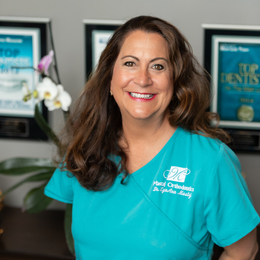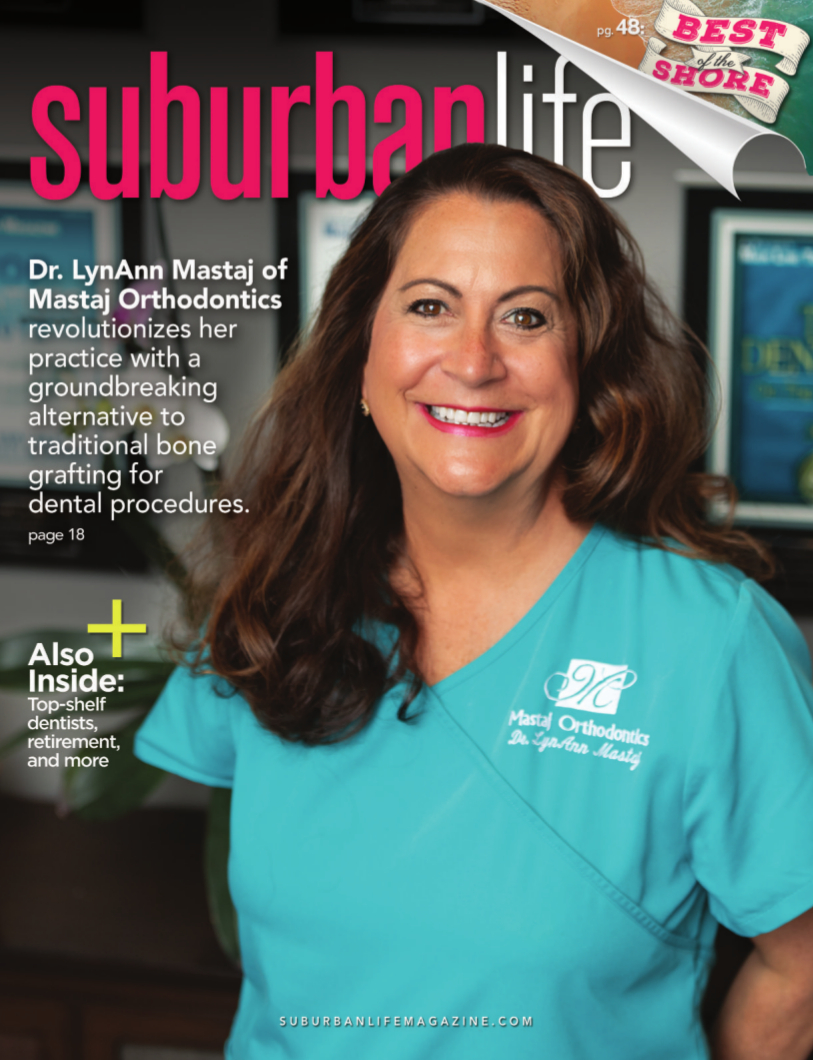
A Better Way Through Innovation
Dr. LynAnn Mastaj of Mastaj Orthodontics revolutionizes her practice with a groundbreaking alternative to traditional bone grafting for dental procedures.
The use of bone grafting to facilitate complex orthodontic procedures has recently experienced a giant leap forward.
Traditionally, such grafts have been invasive, painful ordeals that involved detaching the gums, removing bone from one part of the body—the hip, for example—and then transplanting it to the mouth using metal screws, meshes, and membranes to secure the graft prior to suturing the gums. Patients underwent multiple surgeries, resulting in significant inconvenience and discomfort, all in pursuit of a healthy smile. In recent years, however, a small group of leading practitioners such as LynAnn Mastaj, D.M.D., has adopted alternatives that offer less painful, and less invasive treatment along with better results.
Dr. Mastaj cites the Subperiosteal Minimally Invasive Aesthetic Ridge Augmentation Technique, or S.M.A.R.T.® Developed by Ernesto Lee, D.M.D., an innovator in the field of Implantology and Aesthetic Dentistry (as well as Dr. Mastaj’s husband), the procedure provides a minimally invasive alternative to traditional approaches, which are fraught with complications.
She believes S.M.A.R.T. is revolutionary in the world of bone grafting because it provides more predictable results and superior bone regeneration, with less pain and complications for patients. Requiring only a small incision, patented instruments and laparoscopic techniques are utilized to place the bone graft in the target area, achieving greater results with less pain, less swelling, fewer procedures and lower risk of soft-tissue deformities, even in complex cases.
“Developed in 2017 to basically tunnel through a remote minimally invasive incision, S.M.A.R.T. uses specially designed instruments to develop a pouch in areas where bone is deficient,” Dr. Mastaj explains. “The bone graft is mixed with a growth factor and added over the patient’s deficient bone.”
Although similar procedures have been attempted since the 1980s, unpredictable results prevented their widespread adoption. Now, thanks to the techniques developed and patented by Dr. Lee, practitioners can improve patients’ lives by putting bone exactly where a patient needs it without resorting to more aggressive methods.
“For me, this has revolutionized my practice,” says Dr. Mastaj. “In the old days, when a patient was told they required an implant but did not have enough bone, the traditional method resulted in a 75 percent chance of complications. S.M.A.R.T. is a predictable way to graft bone where patients need it, with amazing outcomes. Although it is an efficient procedure with low risk, doctors interested in performing this surgery must learn it and become certified. Training for this technique is not available in universities and hospitals.”
Dr. Mastaj refers to “amazing” histology reports that support patients’ successes with the procedure.
“Your body heals with growth factors, and adding them to the bone graft stimulates new bone to grow faster over the patient’s own bone,” she explains. “People are amazed they don’t have to go into the hospital and have bone taken from their hips and screwed to their jaws under general anesthesia. Instead, they can now be treated with a 45-minute procedure performed in the dental office with local anesthesia.”
Besides offering patients a stronger foundation to support dental implants, the technique can be used to add bone in cases where the palate will be expanded with orthodontic treatment. This multidisciplinary approach can be used to vastly improve the airway of an individual with insufficient bone due to genetics or shrinkage of the palate caused by tooth extraction.
“Someone might have a smaller arch following extractions, a broad tongue, or an elongated palate, and suffer from sleep apnea or other airway issues because of it,” Dr. Mastaj says. “If this happens when a person is a child, it gets worse in adulthood, and might result in the need for surgical expansion, or even removal of the uvula and parts of the soft palate.”
By utilizing a combination of S.M.A.R.T. methodologies and orthodontic aligners such as Invisalign, some patients can see superior results without the need for invasive surgery.
“So many patients think they suffer from ADHD, but really they may have a constricted airway,” Dr. Mastaj explains. “This happens especially with adults who have had extractions or braces before. If a patient has insufficient jaw width to expand, the S.M.A.R.T. bone-grafting method can add bone where needed, and Invisalign can be used to align the teeth and widen the arch without invasive surgery.”
Dr. Mastaj is aided by the latest technology, which includes the first high-resolution CBCT scanner that allows for the analysis of 3D images, leading to more accurate mapping of patients’ mouths. Given her more than 25 years of experience and specialty training in orthodontics, Dr. Mastaj possesses the knowledge and expertise needed to help patients achieve a great smile in the safest, most efficient manner.
“A lot of people don’t realize the value of investing in an orthodontist, who can use their specialty training to achieve the best outcomes,” she adds. “People would also be surprised to learn that 30 percent or more of the population who order aligners online, or from a fly-by-night aligner company, get into trouble—tooth loss or even more severe problems.”
Furthermore, many patients do not realize they suffer from airway constriction. In addition to life-threatening sleep apnea, this condition may cause serious dental issues, leading to the inability to chew properly—and, therefore, poor food digestion and weight gain—which are detrimental to a person’s health.
“I enjoy doing these procedures because I can help a patient with airway issues gain the bone where it needs to be, and then move the teeth into those areas,” she says. “It’s great for me as an orthodontist, and I think any periodontist or oral surgeon would be interested in offering this in their practice. We’ve seen it help patients that have failing implants, and older patients that have gum recession due to age-related thinning of gum and bone. There’s much more to being an orthodontist nowadays than just making a pretty smile.”
For more information, visit lynannmastaj.com and www.smartbonegraft.com.
LynAnn Mastaj, D.M.D. | Mastaj Orthodontics
lynannmastaj.com
976 Railroad Avenue, Suite 100
Bryn Mawr, PA 19010
(610) 525-2277
Photograph by Nina Lea Photography
Published (and copyrighted) in Suburban Life magazine, June 2021.



